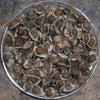Moringa Oleifera Pterygosperma Tree 10/100/500 Seeds, Horseradish Oil Edible Ornamental
The Plant Attraction
$2.99
Moringa Oleifera, Moringa Pterygosperma
Also known as: The Horseradish Tree, Ben Oil Tree, Drumstick tree, Bridal veil
This 25 foot tall deciduous tree is sometimes mistaken for a legume, and is possibly one of the most useful trees in the world. It has delicate foliage and attractive pale white-yellow fragrant flowers that are born in loose clusters in the leaf axils. Flowering and fruiting freely and continuously. It produces long green pods that have been compared to a cross between peanuts and asparagus. The roots are used as a substitute for horseradish and the edible leaves make a highly nutritious vegetable. The roots have also been documented as useful in many folk remedies. The flowers, shoots, and foliage are edible as greens. The name derives from the roots, which taste like horseradish and are used as a substitute. Cattle are particularly fond of them. Young pods are cooked in curries. Seeds, which taste like peanuts when fried, are eaten, but they contain an alkaloid, which limits their use. The unripe pods, known as `susumber' or `drumsticks', are cut up and boiled like beans. The outsides of the pods are extremely hard and woody and impossible to eat; one has to pick them up and eat the sticky pulp inside and `pips' which are lightly hot and delicious. Upon pressing, the seeds yield an oil called ben oil. This non drying oil is used for oiling machinery, in salad oil, and in soaps. Moringa seed oil also has potential for use as a biofuel. The corky bark yields a gum used in India to print calico (cotton cloth with figured patterns).
It is said that 100g of fresh Moringa leaves have 2 times the protein of 100g yogurt. 4 times the calcium of milk, and 3 times the vitamin C of 100g of an orange.
Grows best on a dry sandy soil. Makes an ideal shade tree with high drought resistance. Not cold tolerant, freezes will cause it to die back.
Origin: Eastern India
Choose from packs of 10, 100, and 500 seeds.
Also known as: The Horseradish Tree, Ben Oil Tree, Drumstick tree, Bridal veil
This 25 foot tall deciduous tree is sometimes mistaken for a legume, and is possibly one of the most useful trees in the world. It has delicate foliage and attractive pale white-yellow fragrant flowers that are born in loose clusters in the leaf axils. Flowering and fruiting freely and continuously. It produces long green pods that have been compared to a cross between peanuts and asparagus. The roots are used as a substitute for horseradish and the edible leaves make a highly nutritious vegetable. The roots have also been documented as useful in many folk remedies. The flowers, shoots, and foliage are edible as greens. The name derives from the roots, which taste like horseradish and are used as a substitute. Cattle are particularly fond of them. Young pods are cooked in curries. Seeds, which taste like peanuts when fried, are eaten, but they contain an alkaloid, which limits their use. The unripe pods, known as `susumber' or `drumsticks', are cut up and boiled like beans. The outsides of the pods are extremely hard and woody and impossible to eat; one has to pick them up and eat the sticky pulp inside and `pips' which are lightly hot and delicious. Upon pressing, the seeds yield an oil called ben oil. This non drying oil is used for oiling machinery, in salad oil, and in soaps. Moringa seed oil also has potential for use as a biofuel. The corky bark yields a gum used in India to print calico (cotton cloth with figured patterns).
It is said that 100g of fresh Moringa leaves have 2 times the protein of 100g yogurt. 4 times the calcium of milk, and 3 times the vitamin C of 100g of an orange.
Grows best on a dry sandy soil. Makes an ideal shade tree with high drought resistance. Not cold tolerant, freezes will cause it to die back.
Origin: Eastern India
Choose from packs of 10, 100, and 500 seeds.

























